Mars 2020
Most of us will remember 2020 as the year of covid and lockdowns, but one bright inspiration from 2020 was the number of missions setting out to the red planet. Three exciting missions from three diverse nations and every one was an astounding success. Astra also explore the past Mars mission on the Mars Exploration page. Still in development, check it out as more exciting Mars exploration continues. Mars or Bust!
The journey to Mars is long, but many missions that Earth has launched have successfully reached the red planet and sent back lots of information. It is exciting because Mars (as it turns out) is the best planet in the solar system for humans to colonize. For now the robot orbiters and rover geologists launched in 2020 that have been studying our distant neighbor.
In 2020, three separate missions were launched from Earth before the October 13, 2020 Mars opposition. All three have reached the red planet safely and will begin operations soon.
⋆ ⋆ ⋆
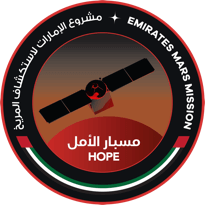
UAE Al-Amal - United Arab Emirates Mars Mission
United Arab Emirates' Mars Mission "Al-Amal" or "Hope" reached Mars on February 9, 2021. Successfully reaching orbit, Amal's mission should last about two years beginning in May 2021. During the mission, The spacecraft will orbit over Mars' equator and study the weather and how the layers of the planet's atmosphere interact. Al-Amal launched on July 19 from Tanegashima island, on a Japanese rocket. The spacecraft carries ultraviolet and infrared spectrometers as well as a high-resolution camera. Its mission is to orbit Mars for two years and collect data on the planet's upper and lower atmospheres. The spacecraft and mission were built and controlled by Mohammed Bin Rashid Space Centre (MBRSC). MBRSC is headquartered in Dubai, United Arab Emirates.
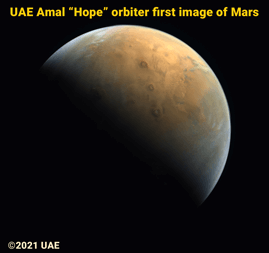
On February 9, the first spacecraft launched toward Mars in July of 2020 was the United Arab Emirates' Mars mission Al-Amal. The spacecraft entered into Mars orbit on February 9, 2021. It is conducting a study the atmosphere of Mars, returning details that have not yet been uncovered. The orbit will allow the spacecraft to view weather over large areas of the planet over time. It began its mission in May 2021 and should send back information for 2 years. The Al-Amal mission is the responsibility of AEU's space agency Mohammed Bin Rashid Space Centre (MBRSC). As of this update, the UAE has officially released 3 data sets from Hope.
Al-Amal's engines fired for 27 minutes to be captured by Mars' gravity and insert itself into orbit around the red planet. This is known as Mars Orbit Insertion (MOI) maneuver. Because of the communication time delay between Mars and Earth, spacecraft need to be able to perform MOI autonomously. The successful arrival and orbital insertion makes the Al -Amal spacecraft the first UAE planetary mission and the the fifth space agency to reach Mars orbit successfully.
After 40 hours traveling in the capture orbit, Al-Amal entered into its science orbit. It uses a type of orbit that is called a semi-synchronous orbit. It orbits Mars once every 55 hours while the rotational period of Mars is 24 hours and 37 minutes. This means that Al-Amal will be above certain regions of Mars for longer time periods that will allow an overview of weather patterns.
Amal is more than just a mission to Mars. The United Arab Emirates wanted to send a spacecraft to Mars that was totally crafted by Arab engineers, scientists, and other workers to help Arabs to enter the world of space development. With some help from other spacefaring nations, the Al-Amal made them the fifth space agency to successfully orbit a spacecraft at Mars. Because the dry Sahara desert is a lot like Mars, the UAE believes that studying Mars will help with the development of plants and crops on Earth. In addition, the Amal probe will inspire younger generations to pursue space science.
Amal carries three scientific instruments. The Emirates eXploration Imager (EXI) is a high-resolution camera that will study the Martian atmosphere in the visible and ultraviolet spectrums. The Emirates Mars Ultraviolet Spectrometer (EMUS), a far-ultraviolet imaging spectrograph that will look for seasonal changes of carbon monoxide and oxygen in Mars' atmosphere, and the Emirates Mars InfraRed Spectrometer (EMIRS), an advanced spectrometer.
The UAE’s is quite serious about space exploration and Mars colonization. They have stated their goal of reaching the Red Planet by 2031. MBRSC has an astronaut training program, the UAE Astronaut Programme that was started in April 2017. September 25, 2019, UAE astronaut Hazzaa AlMansoori flew into space on the Soyuz MS-15 spacecraft to the ISS, and stayed for 8 days. Hazzaa AlMansoori and Sultan AlNeyadi are also training at NASA Johnson Space Center and 2 other astronauts from UAE are to join the NASA's 2021 NASA Astronaut Candidate class.
Information from NASA's Space Science Archive (NSSDCA).
- Find out more at MBRSC's UAE Al-Amal website
⋆ ⋆ ⋆

Tianwen-1 launched by China National Space Administration (CNSA) from Hainan Island on July 23.
China's Tianwen-1 mission reached the red planet and successfully inserted into Mars orbit on February 10, 2021. This mission consists of an orbiter, a lander, and a robot. They became the sixth space agency to orbit a spacecraft at Mars. This very ambitious spacecraft is based on successful missions to the Moon and lunar surface. The target landing place for the lander and the rover is Utopia Planitia (110 degrees E., 25 degrees N.), a huge basin where Viking 2 landed in 1976. The rover named "Zhurong" landed on the surface on May 14, 2021. Tianwen means "heavenly questions" named after a poem by Qu Yuan, a 3rd century poet. The mission includes an orbiter and a lander with a rover, a deluxe mission combo that was never launched before to the Red Planet.
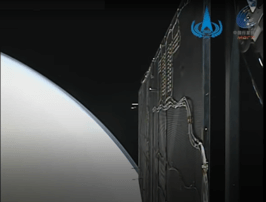
The image of the insertion maneuver here was captured from the CNSA video. The camera mounted on the solar array captured some details of the Martian surface including craters, ridges, and other terrain features. Most impressively, an image on the limb of the red planet revealed the thin atmosphere of Mars. Close examination will even show layers in the atmosphere. It is very impressively thin! The spacecraft performed a 15-minute burn to slow down for Mars capture. On February 24, Tianwen-1 entered parking orbit, with its closest point (periareon) to the planet at 280 km and the farthest point (apoareon) at 59,000 km. Tianwen has a total of 13 instruments on the spacecraft.
The orbiter has a Medium-Resolution Camera (MRC) that has a resolution of 100 m from a 400-km orbit and a High-Resolution Camera (HRC) with a resolution of 2 m from a 400-km orbit. It also has a Mars Magnetometer (MM), Mars Mineralogy Spectrometer (MMS), Orbiter Subsurface Radar (OSR), the Mars Ion and Neutral Particle Analyzer (MINPA), and Mars Energetic Particle Analyzer. It will find the most promising spot on Utopia Planitia for the rover to set down and begin its mission.
The rover has Ground-Penetrating Radar (GPR), that functions down to about 100 m (330 ft.) below the Martian surface, the Mars Surface Magnetic Field Detector (MSMFD) to measure the changing magnetic field on Mars, the Mars Meteorological Measurement Instrument (MMMI), and the Mars Surface Compound Detector (MSCD), a spectrometer. The rover also has two cameras: the Multi-Spectrum Camera (MSC) and the Navigation and Topography Camera (NTC).
The Zhurong rover has completed its 3 month mission and is still active on the surface The orbiter should last at least one Martian year. CNSA worked with international agencies to assist with various instruments on the mission. French scientists contributed to the MSCD instrument and gave advice on other instruments on the rover as well. Austrian scientists assisted with the magnetometer on the orbiter. Tracking the probe was assisted by the European Space Agency with ground radio telescopes.
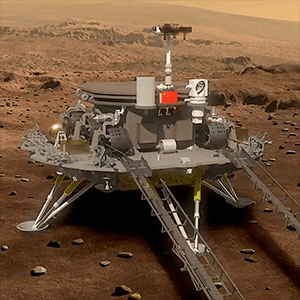
Spaceflight Now has a good article on the Tianwen mission at Mars: China’s first Mars mission enters orbit around Red Planet
⋆ ⋆ ⋆

Mars Perseverance Rover - Launched on July 30, 2020, landed on Mars February 18, 2021.
NASA's Mars Perseverance Rover touched down on the surface of Mars on February 18, 2021. During entry, descent, and landing Perseverance used cameras to capture the entire landing sequence that NASA calls the "seven minutes of terror" between when the spacecraft hits the outer atmosphere and the rover touches down. Because Mars is so far away, the communication delay means that the spacecraft must perform the landing without guidance from the mission planners. Unfortunately the onboard microphone failed to recorded landing, but the rover has a microphone that is sending back sounds from the martian surface. Perseverance is exploring Jezero Crater on the red planet. The rover is also called Persy and will be searching for signs of water, microbial life and hopes to reveal more about the history of Mars. Perseverance rover has a sample caching system that will collect and package samples for return to Earth by a future mission. The future mission will leave Mars using a Mars Ascent Vehicle, this has never been done and paves the way for future return missions from Mars.
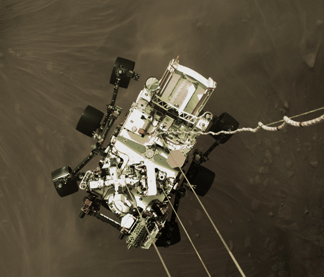
Jezero Crater
Perseverance mission is to explore Jezero crater, a ~45 km impact crater on the northwest margin of the Isidis impact basin, in the Nili Fossae region of Mars. This region is a very important area for understanding the formation of the Isidis basin, the alteration and erosion of the crater. There was subsequent volcanism and other modification to the surface. The crater rim has been breached in three places: twice where channels from the neighboring highlands to the west have drained into the crater from the northwest, and one on the eastern side where the crater drained into the Isidis basin. Each of the channels deposited deltas on the crater floor that have been preserved. High-resolution images and spectral data have reveal sedimentary structures, clay deposits, and areas of the crater floor that appear to have been resurfaced by lava.
Perseverance's instruments include two cameras: Mastcam-Z is mounted on the rover’s mast that will allow the rover to take detailed images of distant objects and SuperCam that uses a camera, laser and spectrometers. The Mars Environmental Dynamics Analyzer (MEDA) sensors are to take measurements of temperature, pressure, humidity, and other environmental conditions. The Mars Oxygen ISRU Experiment (MOXIE) will produce a small amount of oxygen (O2) from Mars' atmosphere. The Planetary Instrument for X-Ray Lithochemistry (PIXL)is an X-ray spectrometer with a high-resolution camera. The Radar Imager for Mars' subsurface experiment (RIMFAX) is ground-penetrating radar that can penetrate from the surface down to 30 feet (more than 10 meters). The Scanning Habitable Environments with Raman and Luminescence for Organics and Chemicals (SHERLOC) is mounted on the rover's robotic arm.
NASA engineers sent a hidden message on the parachute that slowed Perseverance down while it traveled through Mars' atmosphere to the surface. Mission engineers wanted to include a pattern in the fabric of the parachute that would help them see the way it was oriented during the descent to the surface. This would help them to determine how well the parachute functioned during the descent.
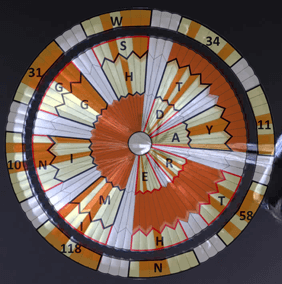
Ian Clark, an engineer working on the Perseverance mission decided that he would make it a little fun. He used binary code to spell out, "Dare Mighty Things" a JPL motto. (This was originally a quote by Theodore Roosevelt.) Using 2 colors, Ian was able to encode the message in binary with 1 being orange and 0 being white. For the main message, the numbers have to be matched up with alphabet letters starting with A = 1. NASA published this image decoding the parachute message. Along the border of the chute, the code is 34 11 58 N 118 10 31 W or 34 deg. 11 min. 58 sec. N. 118 deg. 10 min. 31 sec. W., the latitude near the Jet Propulsion Laboratory's visitor center.
NASA released images of all the plaques that were attached to Perseverance Mars Rover before launch. These include a tribute to health care workers who have been fighting the corona virus pandemic back on Earth in 2020. The rover's Mastcam-Z carries a message that is very important question to NASA, "Are we alone? We came here to look for signs of life, and to collect samples of Mars for study on Earth. To those who follow, we wish a safe journey and the joy of discovery." My favorite is the plaque that shows the evolution of the rovers that NASA has sent to Mars. Starting with the Sojourner rover, the figure moves through all the others, ending with Perseverance. Etched on the plaque and leading Perseverance is the image of the tiny helicopter, Ingenuity.

(Plaque on 2020 Rover)
- Read more about Perseverance Rover on Astra's Perseverance page!
⋆ ⋆ ⋆
